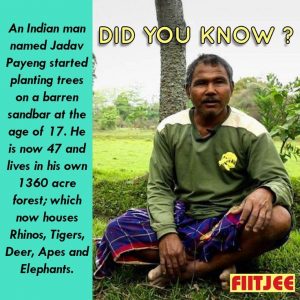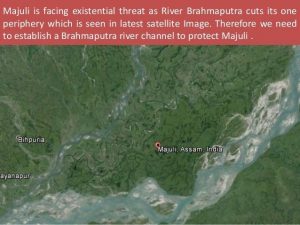About Majuli
Majuli is the biggest river island in the world, in the Brahmaputra River in Assam. It is the first island district of India. The island had a total area of 1,250 square kilometres (483 sq mi) at the beginning of the 20th century, but a big chunk of the land is lost significantly to erosion. Nearly, 352 square kilometres was lost in the massive floods of 2014. Majuli has shrunk as the river surrounding it has grown. Yet, it is recognised by Guinness Book of World Records as World’s Largest River Island. Majuli remains a land of rich cultures and a melting pot of diverse tribes.
The island was formed over a period of time due to frequent major earthquakes, causing the Brahmaputra to change course, as well as high floods; both are common phenomena in Assam. Annual flooding carries silt from the upper reaches, making the land fertile and creating marshes on the island. Majuli is therefore a biodiversity hotspot, with more than 260 species of birds, both resident and migratory, being recorded on the island and in its surrounding water bodies. Some of the rarest plants, herbs, shrubs are found here.
Majuli needs to be protected from the wrath of Brahmaputra River each year, as it is fast-disappearing the Island. Regular floods in the Brahmaputra swamp the island and cause erosion, washing away villages and displacing residents. The rate of erosion is so severe that it is likely to submerge the island in the next 15-20 years, according to Majuli Island Protection & Development Council, a non-profit organization.
The latest Chief Minister of Assam, Sarbanda Sonowal, was elected as MLA from Majuli in the state assembly elections. One of Sonowal’s poll promises was to build a bridge connecting the island to Jorhat if he became chief minister. Presently, the island can be accessed only by ferry and the construction of a bridge has been a long-standing demand of its residents. Sonowal had also promised to preserve and promote Majuli’s cultural wealth. Preserving the island itself will also be a priority for the government.
About Jadav Payeng
However, this article is written as a tribute to Jadav “Molai” Payeng, a simple Mising tribesman (ethnic tribes in Assam) in India. He began planting seedlings on a barren sandbar in Jorhat district in 1979. Some 35 years later, he is credited with single-handedly planting and nurturing a forest that is bigger than Central Park in New York!! Mr. Payeng did not set out with an ambition to seek name and fame; rather, he was terribly touched by the massive disruptions of the island each year. But, in 1979 in the devastating floods which washed onshore a huge heap of garbage, hundreds of snakes were also washed up. The snakes died in the excess heat on that sandbar. Payeng could not withstand the sight; he was just 16 at the time.
Clad in a missing tribal dress (lower garment and a short-sleeved top) he cycles about 1-1/4 miles to Kartik Chapori, then rows his boat to get to the other side of the river. He has to cycle for another three miles to reach the forest. And, he makes this trip every day. He is studied up to the 10th standard at a school in Jorhat and currently lives in the nearby village of Kokilamukh with his wife and three children. He owns about 50 cows and buffaloes and sells milk for a living. His day starts before dawn when he milks the livestock. By 10 in morning he starts on his way to the forest.
Jadav Payeng is the forest man whose life object is conservation of the eco-system of Assam. Payeng in true sense is a saviour of Mother Nature. The forest planted by Payeng is now known as Molai Kathoni. Molai is Payeng’s nickname and kathoni meaning forest in Assamese. The density of the woods makes it hard to believe it has been planted by a single human. Payeng’s work goes far beyond saving snakes. The forest has numerous varieties of plants and among the thousands of trees it has tamarind, teak, jackfruit, silk cotton, mango, mulberry, Indian rosewood, banyan, and custard-apple. As Payeng cultivates the forest single handed, it was difficult to water the entire area by himself, so he devised a clever but simple solution. He bought some big earthen pots which could hold five litters (more than a gallon) of water, and made small holes at their bottoms; he then tightened the holes with hay and placed the water-filled pots on the ground near the growing saplings.
This made the water drip slowly, and it was possible to water this 1,360-acre area every day. The forest has also been home to tigers, rhinoceroses, rabbits, deer, vultures, eagles, monkeys and a huge variety of birds. You will hear the rustle of leaves swayed by the breeze along with the sound of the cuckoo bird. Payeng is happy that the jungle is a home to the tiger, herds of elephants, as well as deer and rabbits and birds.
When someone is doing good work, not everyone, appreciates his/her work. Around 2008, a herd of wild elephants destroyed homes in the village of Aruna Chapori. When the residents came to know that Payeng had planted a forest in which the elephants were taking shelter, they grew violent and wanted to destroy the forest. Payeng strongly objected. “Cut me before you cut down the trees,” he told them. His simple logic has been that trees have always helped the human race and they should be protected and respected to conserve the environment.
Some NGOs like “Seven Look’’ work to help residents understand Payeng’s efforts. They are trying to provide helping hand to Jadav by educating the people of the neighbourhood. According to Jadav Paeng, environmental education should be made compulsory starting in primary school. Every student taking admission in a school should practically plant and nurture two saplings, only then will they earn their own oxygen. He is so right!! We all should appreciate that we co-exist with the nature.
Payeng also says that India’s education system should place more importance on the implementation of what is being taught. “Students are reading about global warming and the needs of the environment in books, but they are not doing anything for the environment practically,” he laments. Payeng’s work was unknown to the world until Jitu Kalita, a local journalist and wildlife photographer, accidentally discovered him in the forest. He published an article about Payeng’s work in a local newspaper in 2010. The former president of India, A.P. J. Abdul Kalam, was the one who gave him the name “Forest Man of India”. This recognition came after a short film was made by photographer Jitu Kalita and a series of articles circulated the globe.
In 2013, William Douglas McMaster completed a short documentary on Payeng’s work, titling it “Forest Man.” It won the 2014 Best Documentary prize at the Emerging Filmmaker Showcase in the American Pavilion at the Cannes Film Festival. And last year, Payeng was conferred the ‘’Padma Shri’’, the fourth highest civilian award given by the government of India.
With sheer hard work and perseverance, Jadav has shown the world the power of will – what a single man can do if he decides. Payeng now receives donations from abroad. Also, he has employed four people who assist him with planting trees. Payeng’s efforts continue even today in full swing. The name and fame has not gone to his head. The forest man continues to plant trees with the help of his family. And the planting is much easier than when he started, having seeds from established trees to grow more. Imagine, one man can bring such a positive change, let’s say another 5-10 people strengthen his hands, the Majuli landscape will transform positively further!!!
















































